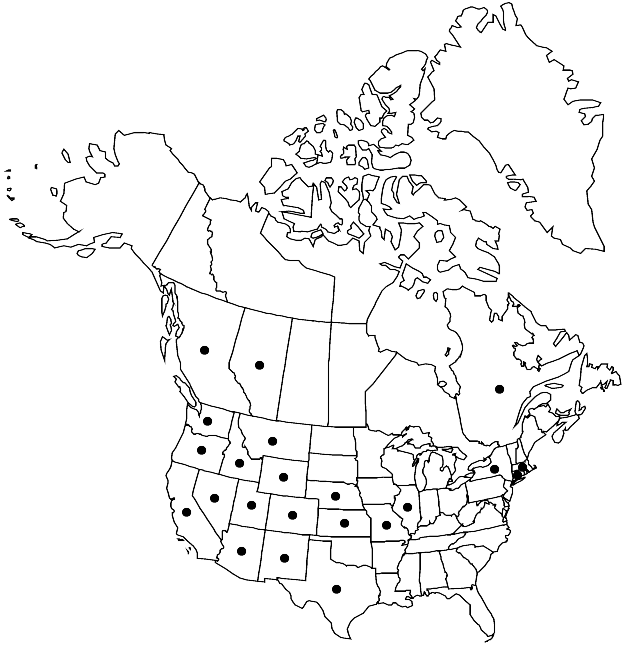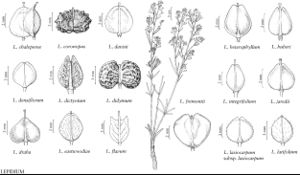Difference between revisions of "Lepidium latifolium"
Sp. Pl. 2: 644. 1753.
FNA>Volume Importer |
FNA>Volume Importer |
||
| Line 11: | Line 11: | ||
|name=Cardaria latifolia | |name=Cardaria latifolia | ||
|authority=(Linnaeus) Spach | |authority=(Linnaeus) Spach | ||
| + | |rank=species | ||
}} | }} | ||
|hierarchy=Brassicaceae;Brassicaceae tribe Lepidieae;Lepidium;Lepidium latifolium | |hierarchy=Brassicaceae;Brassicaceae tribe Lepidieae;Lepidium;Lepidium latifolium | ||
| Line 34: | Line 35: | ||
-->{{#Taxon: | -->{{#Taxon: | ||
name=Lepidium latifolium | name=Lepidium latifolium | ||
| − | |||
|authority=Linnaeus | |authority=Linnaeus | ||
|rank=species | |rank=species | ||
| Line 50: | Line 50: | ||
|publication year=1753 | |publication year=1753 | ||
|special status= | |special status= | ||
| − | |source xml=https://jpend@bitbucket.org/aafc-mbb/fna-data-curation.git/src/ | + | |source xml=https://jpend@bitbucket.org/aafc-mbb/fna-data-curation.git/src/f50eec43f223ca0e34566be0b046453a0960e173/coarse_grained_fna_xml/V7/V7_947.xml |
|tribe=Brassicaceae tribe Lepidieae | |tribe=Brassicaceae tribe Lepidieae | ||
|genus=Lepidium | |genus=Lepidium | ||
Revision as of 22:20, 16 December 2019
Perennials; (rhizomes thick, caudex woody); glabrous or pubescent. Stems simple from base, erect, branched distally, (2–)3.5–12(–15) dm. Basal leaves not rosulate; petiole 1–9(–14) cm; blade elliptic-ovate to oblong, (2–)3.5–15(–25) cm × (5–)15–50(–80) mm, (leathery), margins entire or serrate. Cauline leaves sessile or shortly petiolate; blade oblong to elliptic-ovate or lanceolate, (1–)2–9(–12) cm × 3–45 mm, base cuneate, not auriculate, margins serrate or entire. Racemes (subcorymbose panicles), slightly elongated or not in fruit; rachis glabrous or sparsely puberulent, trichomes straight, cylindrical. Fruiting pedicels ascending to divaricate, straight or slightly curved, (terete), 2–5(–6) × 0.1–0.2 mm, glabrous or puberulent adaxially. Flowers: sepals suborbicular to ovate, 1–1.4 × 0.8–0.9 mm; petals white, obovate, 1.8–2.5 × (0.8–)1–1.3 mm, claw 0.7–1 mm; stamens 6; filaments 0.9–1.4 mm, (glabrous); anthers 0.4–0.5 mm. Fruits oblong-elliptic to broadly ovate or suborbicular, (1.6–)1.8–2.4(–2.7) × 1.3–1.8 mm, apically not winged, apical notch 0(–0.1) mm deep; valves thin, smooth, not veined, glabrous or sparsely pilose; style 0.05–0.15 mm, exserted beyond apical notch (when present). Seeds oblong, (0.8–)1–1.2 × 0.6–0.9 mm. 2n = 24.
Phenology: Flowering Jun–Sep.
Habitat: Pastures, grasslands, disturbed places, fields, roadsides, slopes, saline meadows, stream banks, waste grounds, dry flats, sagebrush and pinyon-juniper communities, barren hillsides, ditch banks, edge of marshes
Elevation: 0-2500 m
Distribution

Alta., B.C., Que., Ariz., Calif., Colo., Conn., Idaho, Ill., Kans., Mass., Mo., Mont., Nebr., Nev., N.Mex., N.Y., Oreg., Tex., Utah, Wash., Wyo., s Europe, Asia, n Africa, introduced also in Mexico (Durango, San Luis Potosí), Australia.
Discussion
Selected References
None.
